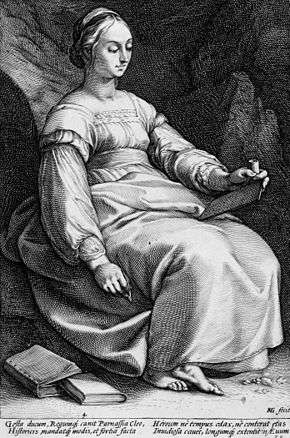Clio (Hendrik Goltzius)
 | |
| Artist | Hendrik Goltzius |
|---|---|
| Year | 1592 |

Hendrik Goltzius' engraving of Clio is the fourth in his series on the nine Muses, and was executed in 1592. It depicts the Greek muse of history seated, holding a pen in her right hand and a tablet and inkwell in her left, with two books at her feet.[1][2][3] She is drawn, wrote historian Natalie Zemon Davis, "with a faint smile, perhaps ironic, certainly detached. From this picture, it is only a short step to some Renaissance representations of History as a winged woman writing, her white garb signifying that she bears witness to truth as well as to renown."[3] Four lines about Clio, in Latin hexameter by 16th-century Dutch poet Franco van Est (Franco Estius), form a caption at the bottom of the engraving.[2][4]
Laurel Thatcher Ulrich has proposed Goltzius' figure as an inspiration for Daniel Chester French's 1884 bronze John Harvard, which shows John Harvard in a similar pose and with similar accoutrements.[5]
The series was printed in folio size, and was dedicated to Goltzius's friend and fellow engraver Jan Sadeler.[6] It was one of several series of engravings that Goltzius made upon returning to his home in Haarlem after spending the years 1590–1591 studying art in Italy,[7] where he came under the influence of a school of engraving founded by his fellow Dutchman Cornelis Cort.[8]
Prints of the work are held by the Dutch Rijksmuseum,[4] the British Museum,[9] the National Gallery of Art (Washington, D.C.),[10] the Los Angeles County Museum of Art,[11] and the Harvard Art Museums.[12] The engraving has been printed in five different states; the British Museum has the second state, for instance,[9] while the Harvard Art Museums have the third.[12]
References
- ↑ Ortiz, Antonio Domínguez; Sánchez, Alfonso E. Pérez; Gállego, Julián (1989). Velázquez. Metropolitan Museum of Art. pp. 225–227. ISBN 978-0-87099-554-5.
- 1 2 Hirschmann, Otto; Moes, Ernst Wilhelm (1921), Verzeichnis des graphischen Werks von Hendrick Goltzius, 1558–1617 (in German), Leipzig: Klinkhardt & Biermann, pp. 61–62
- 1 2 Davis, Natalie Zemon (February 1988), "History's two bodies", The American Historical Review, 93 (1): 1, doi:10.2307/1865687.
- 1 2 Clio, Hendrick Goltzius, 1592, Rijksmuseum, retrieved 2016-09-25.
- ↑ Ireland, Corydon (October 2, 2013), "Biography of a bronze: John Harvard in detail, 375 years after his death", Harvard Gazette.
- ↑ Rees, Abraham (1819), "Low Countries, Engravers of The", The Cyclopædia: Or, Universal Dictionary of Arts, Sciences, and Literature, 21, Longman, Hurst, Rees, Orme & Brown.
- ↑ "Hendrick Goltzius", Encyclopédie Larousse en ligne (in French), retrieved 2016-09-26.
- ↑ Hind, Arthur Mayger (1908), A short history of engraving and etching, London: A. Constable, p. 120.
- 1 2 "The Nine Muses, Plate 4: Clio", British Museum Collection online, retrieved 2016-09-25.
- ↑ Hendrik Goltzius: Clio, Probably 1592, National Gallery of Art, retrieved 2016-09-25.
- ↑ "Clio", LACMA Collections, retrieved 2016-09-25.
- 1 2 From the Harvard Art Museums’ collections: Clio, Harvard Art Museums, retrieved 2016-09-25.